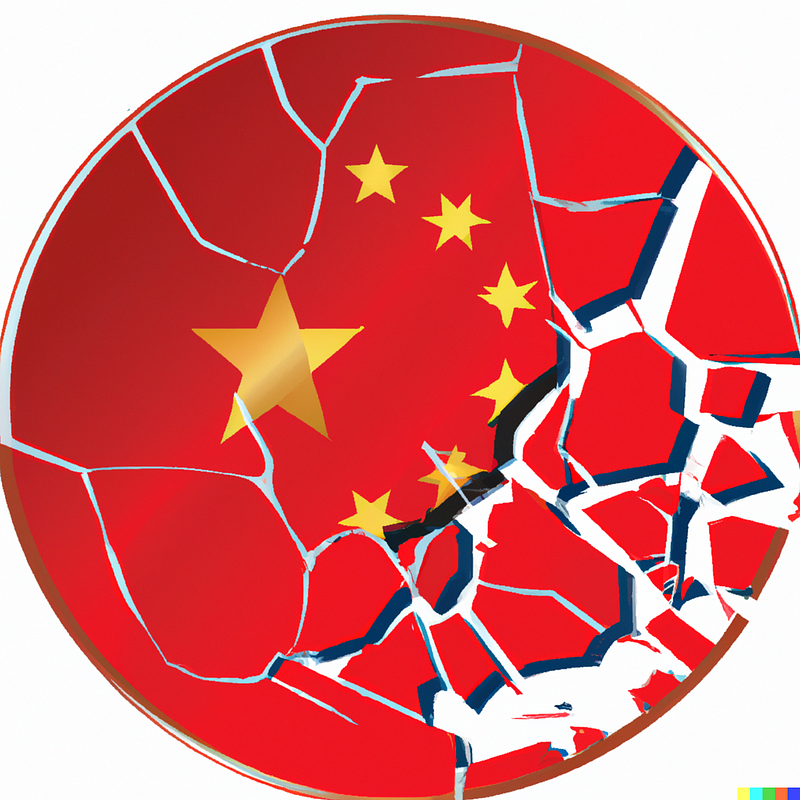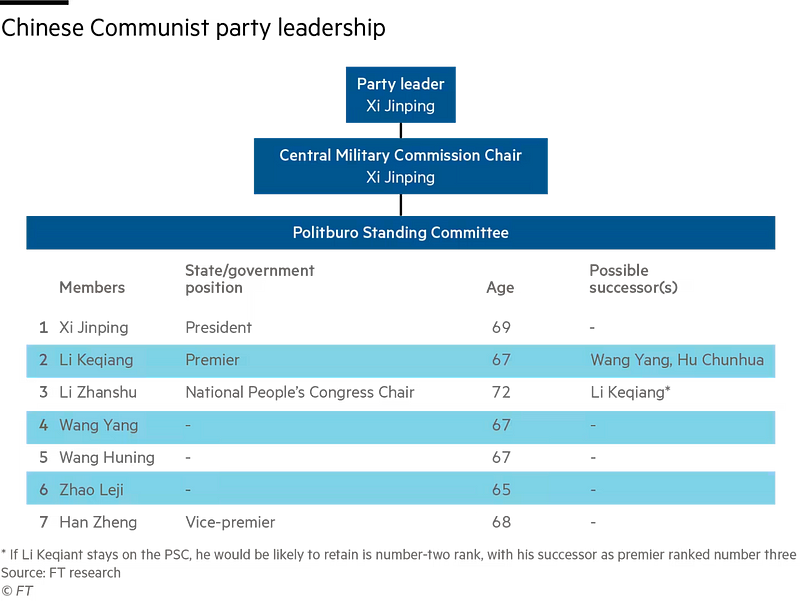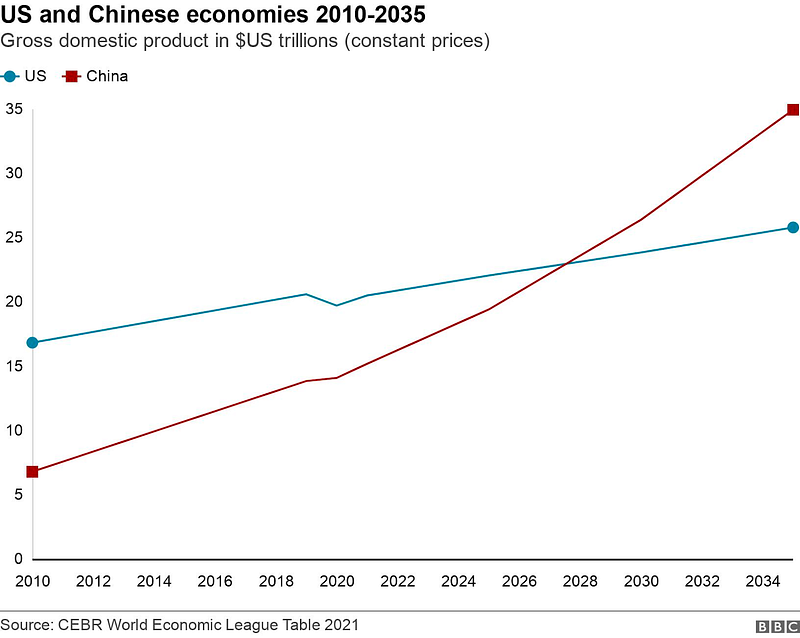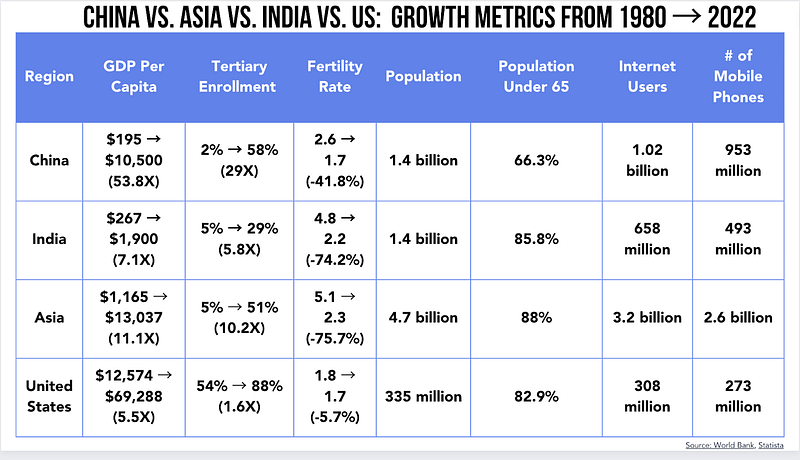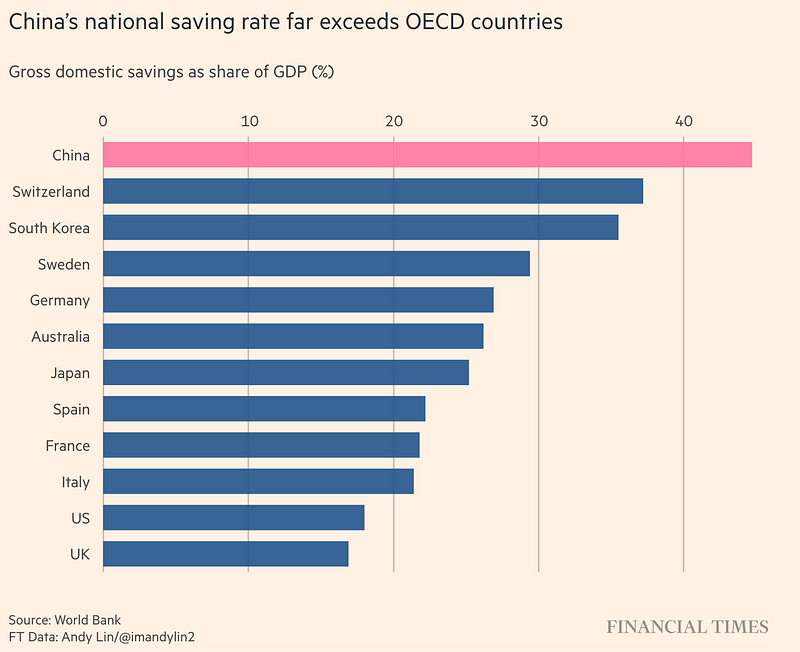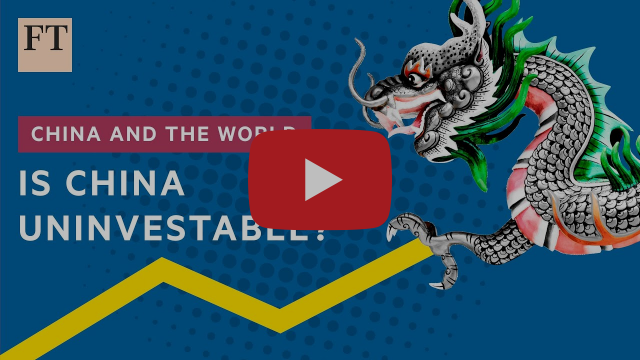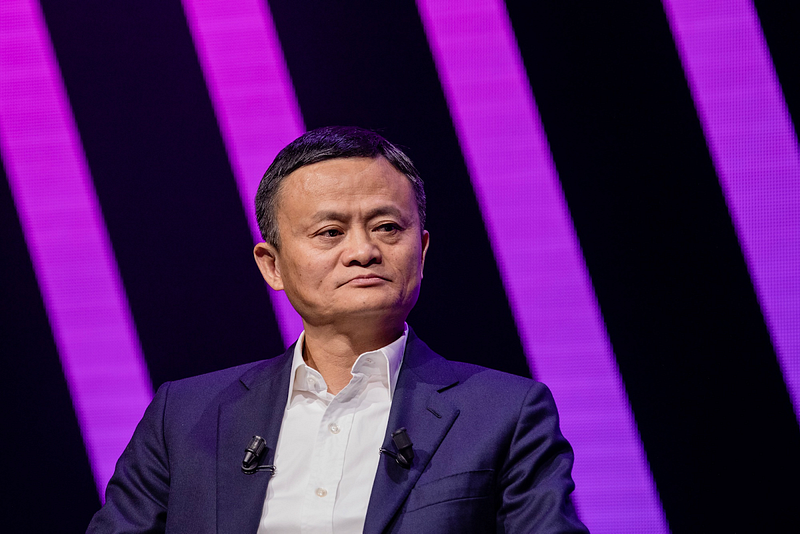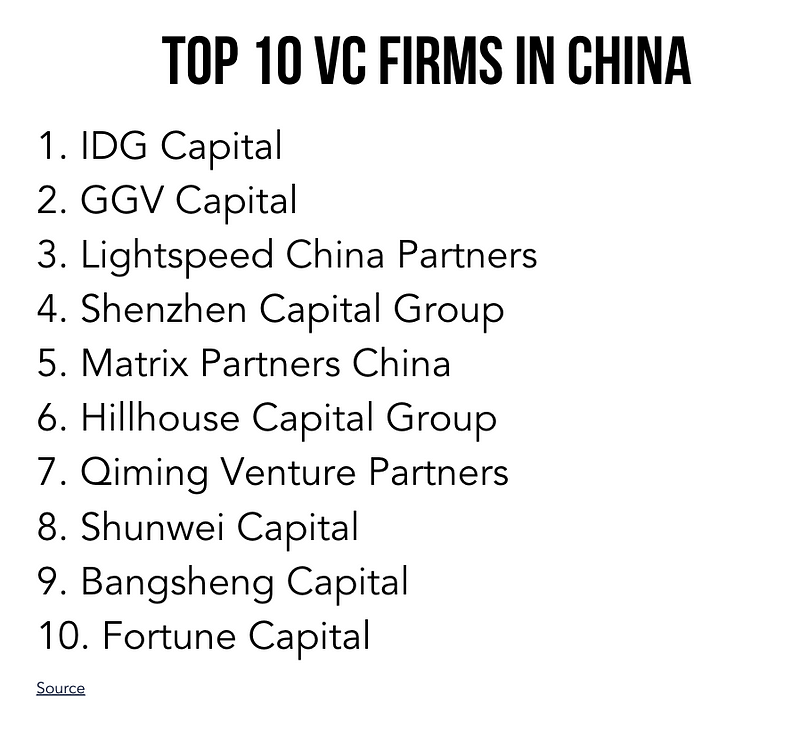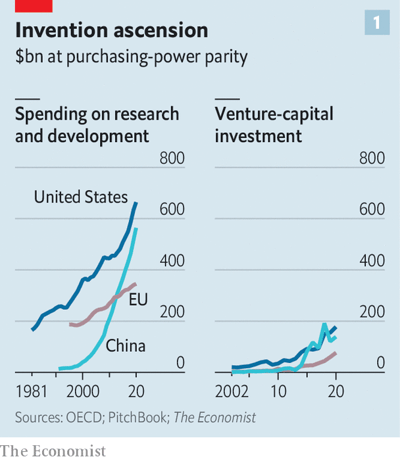“Friends from the press, China needs to learn more about the World and the world needs to know more about China.” — Xi Jinping
“When I was growing up, my parents told me to finish my dinner…people in China and India are starving. I tell my daughters, finish your homework…people in China and India are starving for your job.” — Tom Friedman
“China is a sleeping giant. Let her sleep, for when she wakes, she will shake the world.” — Napoleon Bonaparte
Today was the opening for China’s 20th National Congress, its once-every-five-year gathering of the elite in the Communist Party to anoint its next leaders.
If the highly-choreographed meeting goes to plan, Xi Jinping is expected to be appointed for a third term and given his systematic purging of rivals, effectively be made President for life. Not since Mao Zedong has a Chinese leader had such power and authority over the Chinese people.
With China’s continued ascension on the World stage, President Xi’s influence is omnipresent and ubiquitous. Not surprisingly in a recent cover story, The Economist calls Mr. Xi “the most powerful man in the World.” Interestingly, for much of his marriage, Xi wasn’t even the most powerful person in his own house, as his singing celebrity wife Peng Liyuan was far more famous than he was (Forbes still lists her as the 57th most powerful woman in the world).
The numbers tell the story of China’s rise. Forty years ago, China was just a blip in the world economic order. And now, by our projections, it will likely be the world’s largest economy as early as 2028.
GDP per capita is up over 50x since 1980. China has over a billion internet users (the largest internet user base in the world) and 953 million mobile phone users. Moreover, China’s Savings Rate is nearly 3x higher than the US Savings Rate.
One could argue that a fly in the ointment is demographics, which is to some degree, destiny. With nearly 35% of its population over 65, China is old. Hence the change in the one-child policy. But in a Knowledge Economy, China’s focus on education is awe-inspiring, and the most recent world rankings of universities shows China with a major climb.
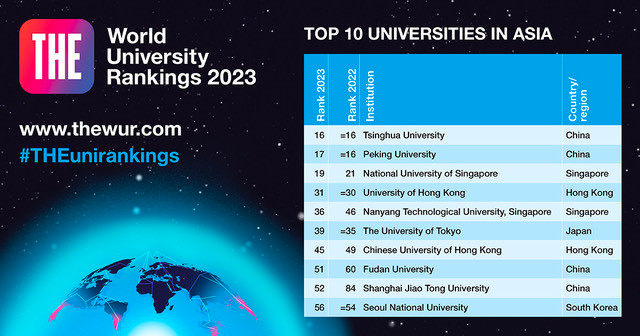
China’s ascent has corresponded with Americans’ increasingly wary view on China. The majority of adults support a more assertive stance with China, even at the cost of harming economic relations. 73% of Americans see the country negatively, up from 36% ten years ago.
While President Obama “pivoted” towards Asia, President Trump fired off volleys with a trade war. President Biden has escalated it, first with the CHIPS Act to limit China’s ability to access advanced processors to make semiconductors, and then writing this week in his National Security Strategy that China has “both the intent…and the power” to reshape the international order.
President Xi has said that “technological innovation has become the main battlefield of the international strategic game.” Accordingly, China’s R&D spend has gone from 33% of the US in 2008 to 85% of its spend in 2020.
We would note that reshaping the international order through economic, military, and technological might is something China has done for centuries.
In technology, the Middle Kingdom brought us paper, the compass, printing and the wheelbarrow. Militarily, they invented gunpowder, the cannon, and the grenade. In economics, paper money. More recently, we’ve seen China develop widespread digital payments, the electromagnetic railgun, and AI that is diagnosing diseases and evermore capturing our attention.
China’s Century?
There’s been five major revolutions in modern history: the English Revolution in 1688, the American Revolution in 1776, the French Revolution in 1789, the Russian Revolution in 1917, and then the Chinese Revolution in 1949.
Spearheaded in 1949 by Mao Zedong, the Chinese Revolution replaced a centuries-old dynastic system with a communist government and spurred rapid industrialization, land reform, and policies that prioritized education and science.
For the foreseeable future, the competing forces for global economic superiority are America’s free market capitalism versus China’s state capitalism.
We’re still experiencing the effects of that fifth revolution, which set the stage for China’s emergence as a global powerhouse and raised President/General Secretary/Chairman Xi to the position of the “most powerful man in the world.” He’s consolidated power and given no indication on when he will step down. And his might is flexing.
Xi’s Belt and Road Initiative (BRI) launched in 2013 is the world’s largest infrastructure project in history. Beijing has already invested over $200 billion to set up roads, rail lines, ports, gas pipelines, green energy, electrical grids and trade arrangements in 139 countries. Expenses are forecasted to reach $1.2 trillion in the next five years.
To give some context, that’s the size of the Infrastructure Investment and Jobs Act, all in overseas investment.
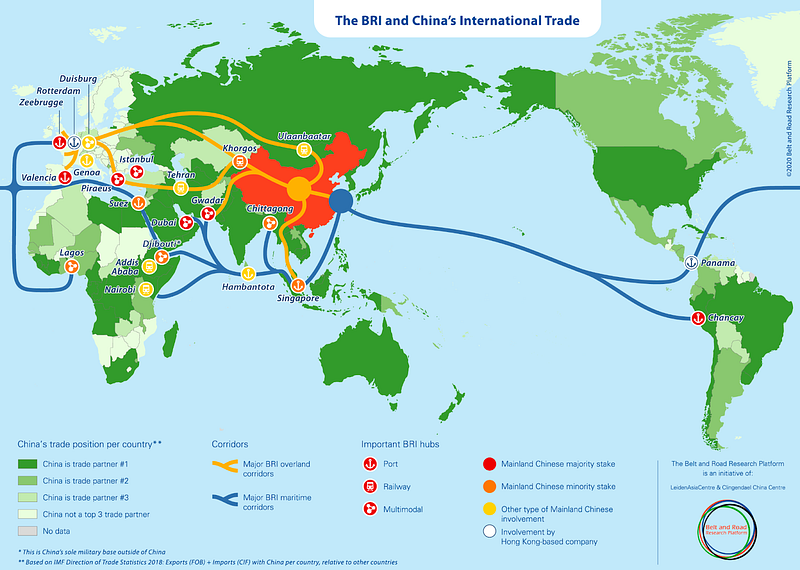
To own the future, China has become a growth investor on a staggering scale, planting its flag in emerging markets throughout Central and West Asia, India, Africa, and the Middle East. It’s a strategic reimagining of China’s place in the world, and a play to increase growth outside its internal markets (which is important as China’s population ages).
Other geopolitical chess pieces are moving around China as well. Saudi Arabia sealed a “strategic partnership” over oil trade in 2016, and took another step this year to prepare pricing oil exports in yuan instead of dollars. India has abstained from votes in the UN that would go against China, like its No Vote on the Uyghur crisis. Russia, whose alliance with Beijing has been called a counter to “western hegemony,” is more beholden to them ever post-invasion of Ukraine.
China Today
China’s 14th Five-Year Plan was adopted in March 2021. The plan focused on what the CCP calls the “internal cycle,” which prioritizes strengthening the domestic economy and facilitating internal social development. China will participate in the “international cycle” of the global economy, but only as a means to support domestic modernization and development.
China’s primary goal is to reduce foreign dependence on innovation and imports and become more of a “superpower” in manufacturing, emerging industries, and geopolitics. Below are the relative priorities of the CCP over the next five years:
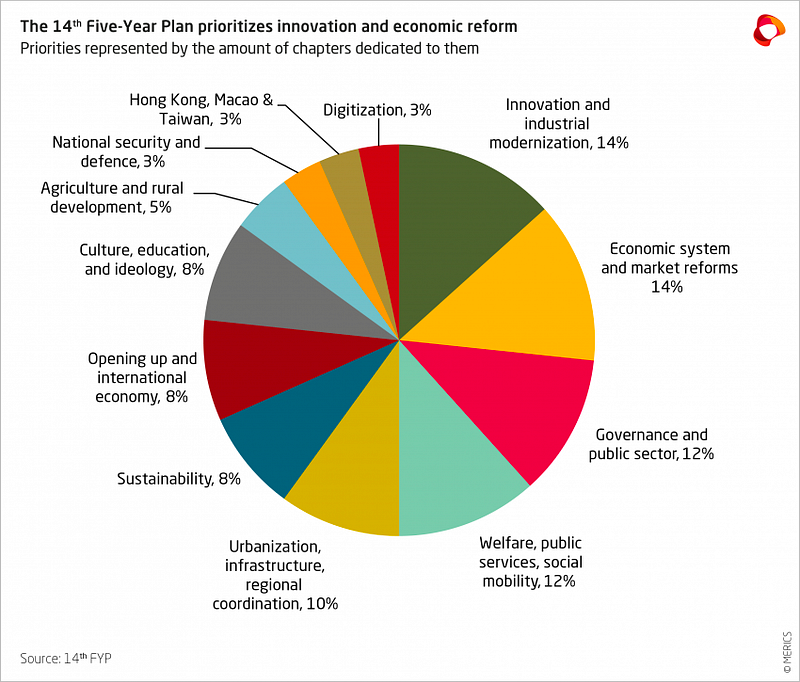
China’s 14th Five-Year Plan is more qualitative than quantitative: this is the first Five-Year Plan with no specific target for GDP growth. But that doesn’t mean that CCP isn’t focused on growing its economy: the word “digital” is mentioned 20x as much as it was in the 13th Five-Year Plan.
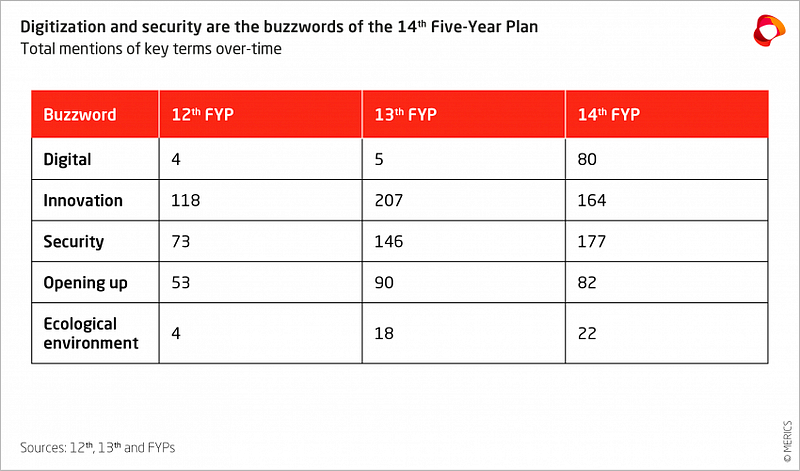
Even though the CCP did not include a GDP growth target in the 14th Five-Year Plan, they’re still focused on taking “arduous efforts” to drive economic growth. In March 2022, China set a projected GDP growth rate of 5.5% and a goal of creating 11 million new jobs in cities and towns. For context, the US has nearly 11 million open jobs today.
While the “state” part of China’s state capitalism is in motion, the “capital” part of China’s state capitalism is in flux. Legions of thoughtful investors say that China is “uninvestable.”
While China’s VC dry powder is still at $122.7 billion, new China-focused funds are slowing down in fundraising:
This retreat is due to three “shocks” that have threatened investor sentiment and made China’s capital markets seem more like “capital punishment.”
The first shock was the “No Ma” incident — Jack Ma’s mysterious three-month absence after his clash with Chinese financial regulators. After Ma accused Chinese banks of operating with a “pawn-shop mentality,” he spent a few months “reflecting” on his comments and mourning Ant Group’s suspended IPO.
The second shock was the July 2021 shutdown of China’s private education sector, which banned companies that teach the school curriculum from making profits, raising foreign capital, or going public. This policy was a complete 180º for China’s private education sector, essentially shutting down the entire industry overnight. Just look at New Oriental’s stock price:
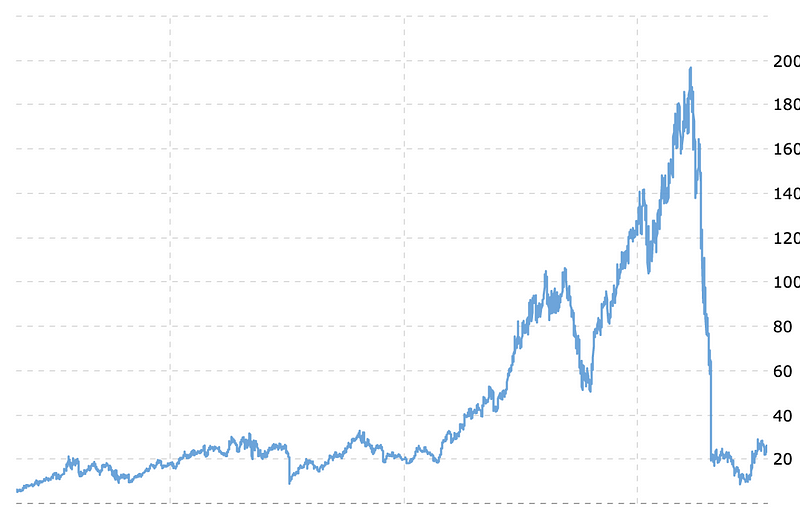
The third shock is not about a specific company or industry, but about China’s guiding ideology: Marxism-Leninism. As Kevin Rudd shares in Foreign Affairs, while most Western thinkers thought that communist ideology was “effectively dead,” Xi has created a new form of Marxist nationalism that shapes China’s economic and foreign policy. Hence the party’s crackdowns on private-sector leaders under the auspices of ‘anti-monopoly’ and ‘data security.’
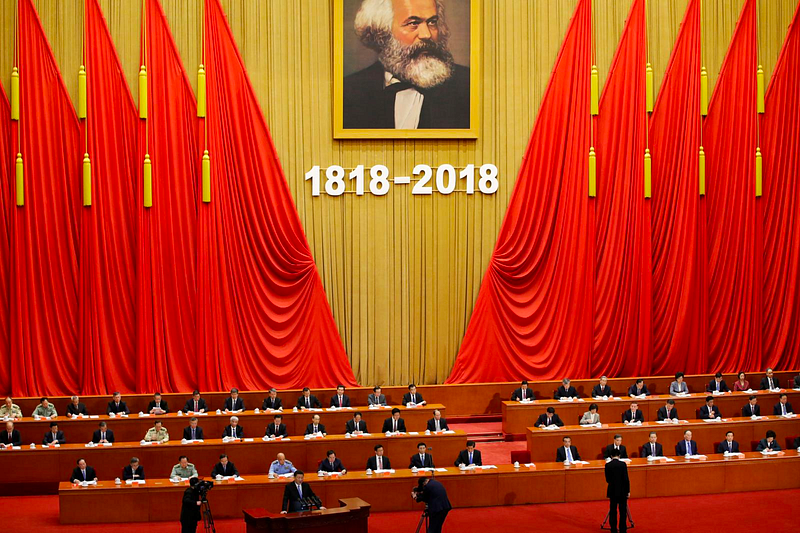
The catalyst behind these three shocks is President Xi and the CCP’s prioritization of keeping control of power, with the greatest threat being an uprising of a disgruntled group of “have-nots.” While many have done fabulously well with the success of Modern China, in a population of 1.4 billion people, many are at risk of being left behind. So as an outsider looking at these changes, you wonder what would cause China to want to “upset the apple cart”? It really boils down to decreasing the risk of losing control.
Xi’s goal is for China to become the preeminent Asian and global power by 2049, along with building a “fairer and more just” international system anchored by Chinese power.
In 2002, then-President Jiang Zemin claimed that China faced a “period of strategic opportunity” for the next twenty years. Xi will do whatever it takes to pursue this “strategic opportunity” over the twenty years to come — even if it comes at the expense of foreign investment, not to mention investor returns.
China’s Technological Prioritization
Zigging while others zag has been a core part of my investment philosophy for thirty years. As many China observers know, the symbol for risk and opportunity is the same in the Chinese language. Today, investing in China represents both.
The truth is that China’s entrepreneurial ecosystem is booming and the country is innovating now more than ever. While many are staying away from China, ignoring this emerging powerhouse is in my view likely to result in missing tremendous opportunities.
There’s nowhere on Earth with more ambition than China. Here’s a story that illustrates this.
I met ByteDance when they were a “star of tomorrow” three or four times. I got off my plane in Beijing, and was late. My meeting was supposed to start at 6pm, and started at 8pm. Not only were they fine with me being late, but the offices were packed and buzzing: no dinner, just work. When I left at 10:30pm, it was still bustling. The drive, ambition and work ethic is off the charts… COVID locked down China, but it hasn’t contained it.
ByteDance isn’t just making short-form mobile videos on TikTok (known as Douyin in China): they’ve also built Lark (their own Slack-like app), BytePlus (a B2B company that sells TikTok’s AI algorithm to other companies), and Resso (a Spotify-style music streaming service).
Historically, brute force imitation and the skirting of international property rights enabled China to leapfrog from a rural economy into the world’s manufacturer. But its reputation as a “copycat nation” is fading as the country advances quickly from imitator to innovator.
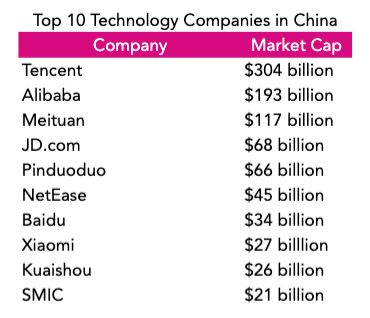
More broadly, there’s a techonomic war over innovation. China is now the leader in international patent applications, and has overtaken the US in top-cited scientific publications. Their spending is growing far faster than the West’s, steered into high-tech state-owned enterprises, which leads to the question: will China’s top-down or the U.S.’s bottom-up approach be more effective?

In 2020, 35% of China’s domestic venture-capital investments went to advanced technology such AI, biotech, green energy, quantum computing, and semiconductors, compared to 20% in the United States. Only 6% of China’s R&D spend is on basic research, compared with 17% of America’s.
We’re better working together than working apart, the kumbaya story goes. It’s generally true, but can only go so far when you have two competing philosophies. On one side you have the Declaration of Independence — a powerful stand for Freedom and Democracy. On the other side, you have the Red Book — which upholds Marx’s dialectical materialism.
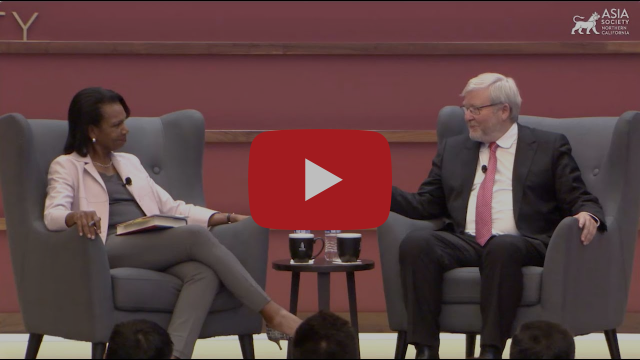
Of course, an egalitarian, worker-controlled state is far from what China has now. There’s 1.4 billion people in the country, but less than 100 million CCP members. The minority has been able to control the majority by increasing the standard of living, lifting 800 million people out of poverty and promising to bring another 370 million into the middle class by 2030.
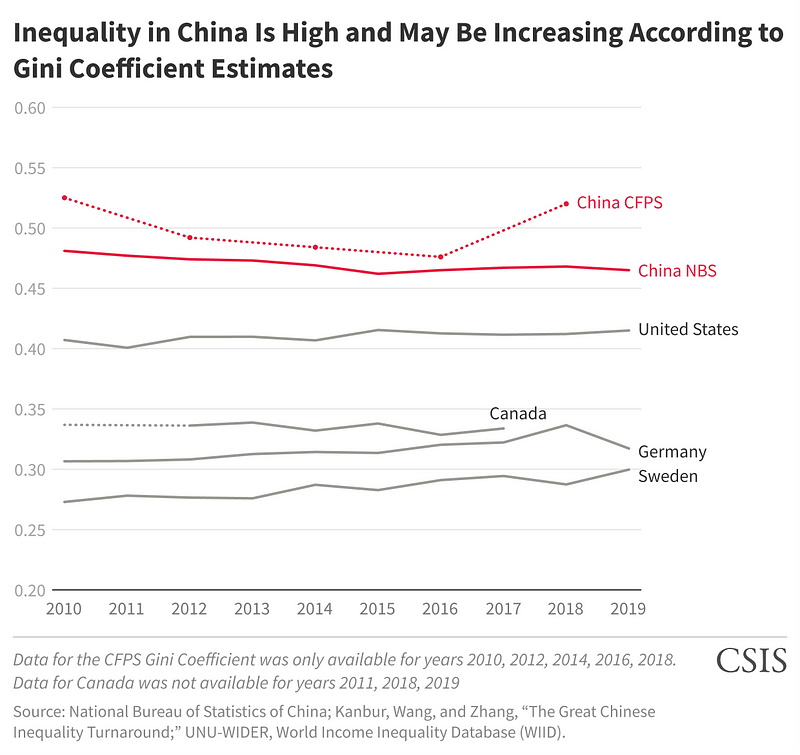
With an aging society and slowing growth, they can only do so much. Lifting of the One Child Policy and encouraging movement to other urban areas outside the major economic hubs is a start. But the ability to create “common prosperity” for all is stretched.
As manufacturing and construction slow, inequality seems to be increasing. Industrial robots and poor rural education will only make this worse.
Everyone knows not to touch a hot stove… but we still have to cook our meals. The ambition of the Chinese people, plus the strategic priorities of the government — in technology, geopolitics, and even space — is such a stove. Playing around risks getting burned. But it might just be the arena to zig while others are zagging.
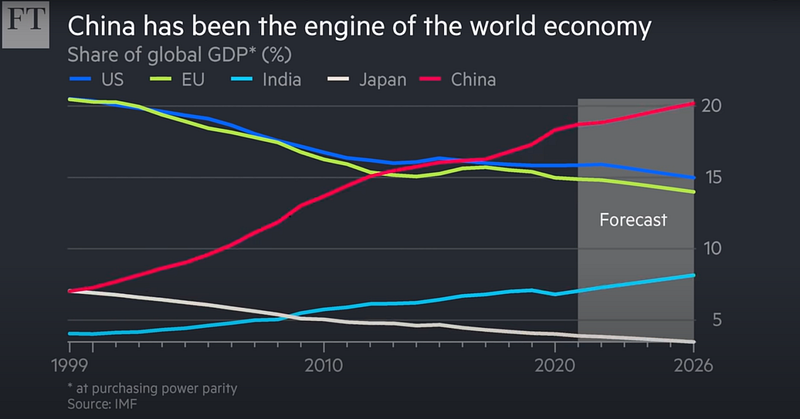
What’s Next for Chinese Education?
China loves education like Joanie loves Chachi. Accordingly, for much of the last thirty years, investing in Chinese education companies has been very fruitful. Obviously, that world got turned upside down after recent regulations from the Chinese government in the summer of 2021.
In a recent conversation with our friend and advisor Joy Chen, formerly the CIO of TAL, she provided some insights on the current state of play in the Chinese education market. Before TAL, Joy was a successful education entrepreneur who had sold her business to TAL.
First, to understand the difference how China works compared to the West, I’ll share a story of the education conference we co-hosted with TAL and New Oriental in Beijing in 2018. We were fortunate to have President Obama as a keynote at the event but were warned that we couldn’t talk about the “4T’s” or the Chinese government could shut the Conference down. The 4T’s were Tiananmen Square, Taiwan, Tibet and Trump.
On the first day of the conference, a very famous Harvard professor gave a speech about China 101 and proceeded to highlight the 4T’s prominently in his speech. Suffice to say, the event almost didn’t have a second day and Joy, who doesn’t drink, could be seen having a couple stiff ones at the bar that night. All that’s to say is that unlike in the United States where we take our freedoms mainly as a given, that’s not the way it works in Beijing.
To summarize the current state of play in China and some of the events that have led us to here, in July 2021 China announced the following regulations for the education market:
Existing tutoring companies specializing in the core K-9 curriculum need to register as nonprofits.
Tutoring companies are banned from raising funds, especially through foreign investment.
Introduction of a “double reduction” policy, aimed at reducing the amount of time spent on homework and time spent in after-school tutoring classes.
Non-academic tutoring is allowed to operate, but it is under regular supervision on operations, like prepayment management, pricing, and content.
In May 2022, policymakers banned educational apps for preschool-age children. This is a clear signal from Beijing that it is committed to limiting the role of private for-profit companies in education.
Later, the Ministry of Education introduced several new measures including a new standard for Chinese proficiency in language education, teaching reform guidelines for PE and health education, and further promotion of vocational education.
These regulations changed the supply side of academic tutoring more than the demand. The demand is still there and is resilient but will become more diversified, especially for the K-12 stage after the “double reduction” policy.
There are three parental requirements for after-school tutoring that we identify for the K-12 stage:
Lift academic scores
Develop well-rounded qualities (Zhongkao and Gaokao reforms with their increased emphasis on non-academic subjects, like sports and the arts.)
Offer childcare services while parents are busy
Meanwhile, academic tutoring demand likely will be replaced by:
Non-profit academic tutoring (but with limited supply)
Non-academic tutoring
Public schools’ after-school service
Daycare service
Learning materials, smart devices, and other edtech products to help with home study
The underground market for one-on-one and small group tutoring
Despite these restrictions, there are still successful companies in the Chinese education space. What’s driving the keys to success for top players right now? Content and technology. The most successful companies have three features:
Well-established brand names
Sufficient cash to support the transition
Strong product development capabilities from learning data accumulated over the years and R&D capabilities from past education experience
As two examples, TAL and New Oriental’s educational efforts are focused on:
TAL: non-academic tutoring, overseas expansion, 2B/2G, and publishing home study learning content.
New Oriental: holistic education for young students (arts or computer programming are not regulated under new policies), services for Chinese students studying abroad, and career training for college students.
Given the current state of play, we see five emerging opportunities in China’s education industry.
Vocational Education
As both policy support and funding for higher-quality vocational training increase, there are big opportunities for vocational education, including career training for college students.
The law also contains provisions encouraging international cooperation, including establishing Sino-foreign cooperative education projects, expanding exchange platforms, and encouraging Chinese vocational education schools to “go abroad.”
2. Holistic Education and Non-Academic Tutoring
As China’s middle class continues to grow, people are looking for more opportunities to learn. The current consolidation level is low and there are not any key players yet, but we think that will change over time.
3. Home Study Content and Devices
This is a trend towards more personalized and digitized smart self-learning devices, powered by AI. EDU has started to offer study machines embedded with intelligent learning materials, while TAL has also started to accelerate its content business by publishing books, i.e., academic learning materials in the format of books. Youdao has also launched a study pad supported by AI technology.
4. Overseas Expansion
Companies such as TAL, AirClass (Zhangmen), Huohua, and Wukon Edu are looking to expand beyond the Chinese market. TAL’s advantage lies in its brand image, its competitive math course content, its premium service (you can get a refund at any point), and Chinese-speaking teachers that attract Chinese parents in overseas markets.
5. E-Commerce Livestream
New Oriental’s Koolearn also explored live-streaming with dual language instruction to sell third-party products on the Douyin platform with Dongfangzhenxuan (DFZX) starting at the end of 2021. The company’s strategy is to explore non-education initiatives through its Koolearn entity while keeping New Oriental (the parent company) focused on education-related business.
What’s clear to us is that in the Global Silicon Valley, the Middle Kingdom matters. We will act accordingly.
Market Performance
This is exactly right….Deutsche Bank strategist Jim Reid said about last week’s market activities “the term roller coaster is one of the most overused, lazy terms to describe the markets, but the last 24 hours are best summed up by being a major roller coaster ride…”
For the week, the Dow ended up 1.2%, the S & P 500 fell 1.6% and NASDAQ dropped 3.1%. The action in between had a significant slope.
Legendary investor Martin Zweig famously coined the strategy “Don’t fight the Fed”…so with rates likely to continue to rise, it’s a perilous environment to be investing in any stocks and especially growth stocks. Inflation came in at 8.2% for September and with that, dashed the hopes that the Fed would tamp down on its March from the current 3 to 3.25% to 4.75 to 5% likely by next year.
Global growth is modest with the IMF lowering its growth estimates to 2.7% and accompanying it with the comment “the worse is yet to come.” Ouch. S & P growth is now expected to be a modest 7% in 2023 but the likelihood that estimates are going to come down more makes the current 16X p/e multiple looks vulnerable.
All this is to say, nobody rings a bell when stocks are ready to go up again but we aren’t expecting things to change for the better any time soon. In the meantime, we will continue to look for great growth companies with the 5P’s at attractive prices and build positions accordingly.
GSV’s Four I’s of Investor Sentiment
GSV tracks four primary indicators of investor sentiment: inflows and outflows of mutual funds and ETFs, IPO activity, interest rates, and inflation. Here’s how these four signals performed this past week:
#1: Inflows and Outflows for Mutual Funds & ETFs
Total Equity Funds went from (-10.1) to (0.1) from 9/28 to 10/5. While this increase may be a signal of confidence, we’ll see if that’s the case after the recent inflation print.

#2: IPO Market
The IPO market continues to stay quiet, but there are signs of life: TripActions, a Palo Alto-based corporate travel and expenses company, raised a combination of debt and equity at a $9.2 billion post-money valuation. The company is rumored to go public in Q2 2023 at a $12 billion valuation.


#3: Interest Rates
The Fed is expected to deliver another large rate hike in three weeks. Traders of US interest rate futures are pricing in a 35% chance that the Fed drives policy rates above 5% next year.
#4: Inflation
The September 2022 inflation print was a wake-up call, as the CPI rose 0.4%. That’s 2x what economists expected (0.2%) and 4x the raise in August (0.1%). Compared to a year ago, prices are up 8.2% year over year, while core inflation is the highest it’s been in 40 years.
EIEIO: Fast Facts
Entrepreneurship… -4.7% — average 20-day performance for the top stocks purchased each day on Robinhood (Source)
Innovation… $1.2 billion — the amount of venture funding raised by climate fintech startups in 2021–3x higher than all previous years combined. (Source)
Education… 47% — the percentage of would-be college students taking classes on YouTube, instead of attending traditional college. (Source)
Impact… $500+ billion — the amount of federal funding estimated by researchers to offset learning loss. Federal funds to schools through school relief funds totaled only $189 billion. (Source)
Opportunity… $13.22 — the median hourly pay of childcare workers — $0.59 less than dog walkers. (Source)
The GSV Big 10
#1 China’s Universities Rise in World Rankings as American Schools Continue to Falter
Here comes yet another data point for China’s ascension on the global stage. If you want to own the future of the knowledge economy, you have to have the smartest people, so universities are a strategic bet. If the US doesn’t buff up its educational priorities, the global center of innovation will inevitably shift eastward.
#2 Lego Owner to Acquire Education-Technology Firm Brainpop for $875m
Lego isn’t just building with bricks anymore — they’re building with companies. The “original teacher” for many children, Lego has been a leader in learning by doing since day one. As Lego continues to expand, buying Brainpop — and its annual audience of 25 million children — is a “no-brainer.”
#3 ACT Scores Fall to Lowest Level In 30 Years
It’s not that you’re just getting older; kids just might be getting dumber — kidding! All jokes aside, we’ve addressed the topic that our country needs a better “test score system.” Regardless of that need, this data is troubling.
For more insights on the news in education and upskilling, subscribe to N2K and The Big 10.
Connecting the Dots & EIEIO…
Old MacDonald had a farm, EIEIO. New MacDonald has a Startup…. EIEIO: Entrepreneurship, Innovation, Education, Impact and Opportunity. Accordingly, we focus on these key areas of the future.
One of the core goals of GSV is to connect the dots around EIEIO and provide perspective on where things are going and why. If you like this, please forward to your friends. Onward!
Make Your Dash Count!
-MM




